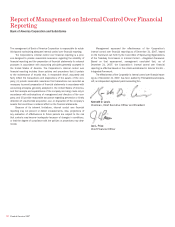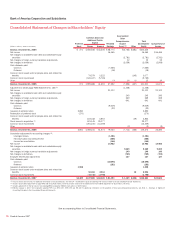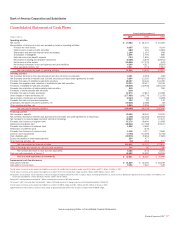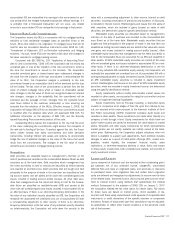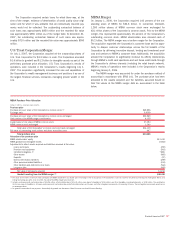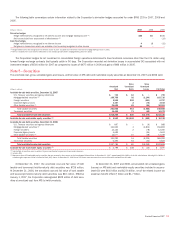Bank of America 2007 Annual Report Download - page 124
Download and view the complete annual report
Please find page 124 of the 2007 Bank of America annual report below. You can navigate through the pages in the report by either clicking on the pages listed below, or by using the keyword search tool below to find specific information within the annual report.The Corporation purchases loans with and without evidence of credit
quality deterioration since origination. Those loans with evidence of credit
quality deterioration for which it is probable at purchase that the Corpo-
ration will be unable to collect all contractually required payments are
accounted for under AICPA Statement of Position 03-3, “Accounting for
Certain Loans or Debt Securities Acquired in a Transfer” (SOP 03-3). SOP
03-3 addresses accounting for differences between contractual cash flows
and cash flows expected to be collected from an investor’s initial invest-
ment in loans acquired in a transfer if those differences are attributable,
at least in part, to credit quality. SOP 03-3 requires impaired loans be
recorded at fair value and prohibits “carrying over” or the creation of valu-
ation allowances in the initial accounting of loans acquired in a transfer
that are within the scope of this SOP. The prohibition of the valuation
allowance carryover applies to the purchase of an individual loan, a pool of
loans, a group of loans, and loans acquired in a purchase business
combination. Under SOP 03-3, the excess of cash flows expected at pur-
chase over the purchase price is recorded as interest income over the life
of the loan. For those loans not within the scope of SOP 03-3, any differ-
ence between the purchase price and the par value of the loan is reflected
in interest income over the life of the loan.
The Corporation provides equipment financing to its customers
through a variety of lease arrangements. Direct financing leases are car-
ried at the aggregate of lease payments receivable plus estimated residual
value of the leased property less unearned income. Leveraged leases,
which are a form of financing leases, are carried net of nonrecourse debt.
Unearned income on leveraged and direct financing leases is accreted to
interest income over the lease terms by methods that approximate the
interest method.
Allowance for Credit Losses
The allowance for credit losses, which includes the allowance for loan and
lease losses and the reserve for unfunded lending commitments, repre-
sents management’s estimate of probable losses inherent in the Corpo-
ration’s lending activities that are carried at historical cost. The allowance
for loan and lease losses represents the estimated probable credit losses
in funded consumer and commercial loans and leases measured at histor-
ical cost while the reserve for unfunded lending commitments, including
standby letters of credit (SBLCs) and binding unfunded loan commitments,
represents estimated probable credit losses on these unfunded credit
instruments based on utilization assumptions. The allowance for loan and
lease losses and the reserve for unfunded lending commitments excludes
loans and unfunded lending commitments measured at fair value in
accordance with SFAS 159 as mark-to-market adjustments related to
these instruments already reflect a credit component. Credit exposures,
excluding derivative assets, trading account assets and loans measured at
fair value, deemed to be uncollectible are charged against these accounts.
Cash recovered on previously charged off amounts are recorded as recov-
eries to these accounts.
The Corporation performs periodic and systematic detailed reviews of
its lending portfolios to identify credit risks and to assess the overall col-
lectibility of those portfolios. The allowance on certain homogeneous loan
portfolios measured at historical cost, which generally consist of
consumer loans (e.g., consumer real estate loans, credit card) and certain
commercial loans (e.g., business card and small business portfolio) is
based on aggregated portfolio segment evaluations generally by product
type. Loss forecast models are utilized for these segments which consider
a variety of factors including, but not limited to, historical loss experience,
estimated defaults or foreclosures based on portfolio trends, delin-
quencies, economic conditions and credit scores. These models are
updated on a quarterly basis in order to incorporate information reflective
of the current economic environment. The remaining commercial portfolios
measured at historical cost are reviewed on an individual loan basis.
Loans subject to individual reviews are analyzed and segregated by risk
according to the Corporation’s internal risk rating scale. These risk classi-
fications, in conjunction with an analysis of historical loss experience,
current economic conditions, industry performance trends, geographic or
obligor concentrations within each portfolio segment, and any other perti-
nent information (including individual valuations on nonperforming loans in
accordance with SFAS No. 114, “Accounting by Creditors for Impairment of
a Loan,” (SFAS 114)) result in the estimation of the allowance for credit
losses. The historical loss experience is updated quarterly to incorporate
the most recent data reflective of the current economic environment.
If necessary, a specific allowance for loan and lease losses is estab-
lished for individual impaired commercial loans measured at historical
cost. A loan is considered impaired when, based on current information
and events, it is probable that the Corporation will be unable to collect all
amounts due, including principal and interest, according to the contractual
terms of the agreement. Once a loan has been identified as individually
impaired, management measures impairment in accordance with SFAS
114. Individually impaired loans are measured based on the present value
of payments expected to be received, observable market prices, or for
loans that are solely dependent on the collateral for repayment, the esti-
mated fair value of the collateral. If the recorded investment in impaired
loans exceeds the present value of payments expected to be received, a
specific allowance is established as a component of the allowance for
loan and lease losses.
The allowance for loan and lease losses includes two components
which are allocated to cover the estimated probable losses in each loan
and lease category based on the results of the Corporation’s detailed
review process described above. The first component covers those com-
mercial loans measured at historical cost that are either nonperforming or
impaired. The second component covers consumer loans and leases, and
performing commercial loans and leases measured at historical cost.
Included within this second component of the allowance for loan and lease
losses and determined separately from the procedures outlined above are
reserves which are maintained to cover uncertainties that affect the Corpo-
ration’s estimate of probable losses including domestic and global eco-
nomic uncertainty and large single name defaults. Management evaluates
the adequacy of the allowance for loan and lease losses based on the
combined total of these two components.
In addition to the allowance for loan and lease losses, the Corpo-
ration also estimates probable losses related to unfunded lending
commitments, such as letters of credit and financial guarantees, and bind-
ing unfunded loan commitments. The reserve for unfunded lending
commitments excludes commitments measured at fair value in accord-
ance with SFAS 159. Unfunded lending commitments are subject to
individual reviews and are analyzed and segregated by risk according to
the Corporation’s internal risk rating scale. These risk classifications, in
conjunction with an analysis of historical loss experience, utilization
assumptions, current economic conditions, performance trends within
specific portfolio segments and any other pertinent information, result in
the estimation of the reserve for unfunded lending commitments.
The allowance for credit losses related to the loan and lease portfolio
is reported separately on the Consolidated Balance Sheet whereas the
allowance for credit losses related to the reserve for unfunded lending
commitments is reported on the Consolidated Balance Sheet in accrued
expenses and other liabilities. Provision for credit losses related to the
loan and lease portfolio and unfunded lending commitments is reported in
the Consolidated Statement of Income in provision for credit losses.
122
Bank of America 2007


